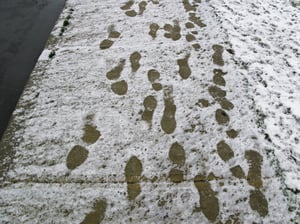 After a quiet December, Mother Nature has really created a ruckus in Wisconsin the last several weeks. From significant amounts of snow to extremely cold temperatures, winter’s back!
After a quiet December, Mother Nature has really created a ruckus in Wisconsin the last several weeks. From significant amounts of snow to extremely cold temperatures, winter’s back!
If you’re fed up with shoveling, it may be time to hire a snow removal service for the remainder of the season. If you’ve recently hired a snow removal service or plan to, you should be aware of the potential risks.
Accidents happen, especially in slippery, icy conditions. What if their worker slips and falls on your driveway or causes damage to your home or to property of others? You might be held responsible. That’s why it’s important to have the proper insurance, for both you and the company, to ensure coverage for potential losses.
Here are some things to do to ensure you’re both protected:
1. Consider requesting a copy of their current Certificate of Insurance. You’ll want to look for two types of coverages:
- Liability insurance covers property damage and injuries caused by their workers.
- Workers’ compensation insurance provides payment to injured workers for lost wages and medical services, regardless of who was at fault.
If they can’t provide proof of insurance, don’t hire them!
2. Verify that they’re bonded.
- Bonding protects you if they fail to complete a job or fail to meet other financial obligations, such as paying for damage the worker caused to your property.
- To determine whether your snow removal service is bonded, ask for a bond number and certification. You should take extra precautions to ensure that both the bond and the license are up to date.
3. Make sure they bring and use their own tools and equipment.
- If you offer your own equipment to them, you assume the responsibility to ensure the equipment is suitable for the job, is in safe condition, and they’re trained to use it.
4. Keep a copy of all paperwork.
- Include proof of licensing (if required), bonding and insurance, the contract, invoices, proof of payment, and all letters and e-mails.
Winter can be a long season and who knows what surprises Mother Nature may have in store. Keep your surprises to a minimum this winter and be prepared if you hire help.
For additional tips on hiring a snow removal service, check out the link below.
Burned out with shoveling snow?
Author Bio: Wendy Wagner is a senior Personal Lines underwriter and has been with West Bend for seven years. In her free time, Wendy enjoys snorkeling and swimming with manatees and sharks. Wendy and her family also love fostering dogs and finding them new homes.
SOURCE: West Bend, Scott Stueber on Feb 12, 2019 9:58:30 AM
 Here in Wisconsin, the weather is consistently throwing us for a loop. Anticipating snow and ice is something we all should do.
Here in Wisconsin, the weather is consistently throwing us for a loop. Anticipating snow and ice is something we all should do. Extreme cold temperatures put your home or business at risk for frozen pipes. As water freezes, it expands and puts pressure on pipes. When there’s too much pressure on pipes, they burst. Most times, the areas you need to be most concerned about are unheated areas, like garages and basements.
Extreme cold temperatures put your home or business at risk for frozen pipes. As water freezes, it expands and puts pressure on pipes. When there’s too much pressure on pipes, they burst. Most times, the areas you need to be most concerned about are unheated areas, like garages and basements. From smart food dispensers and surveillance systems to ingenious toys and crafty crates, tech-savvy pet products are a booming market. Dog-walking robots may not be a reality yet, but we have recommendations for keeping your pets fed, safe, and busy
From smart food dispensers and surveillance systems to ingenious toys and crafty crates, tech-savvy pet products are a booming market. Dog-walking robots may not be a reality yet, but we have recommendations for keeping your pets fed, safe, and busy 
 Let’s face it – winter presents many problems for homeowners. From cold temperatures that make heating systems work overtime, to snow and ice that clog driveways, gutters, and walkways, winter creates a wide range of challenges that can cost time and money. But that’s not all—winter can make it tough to maintain privacy as well. Thanks to winter’s short days and long nights, homeowners need well-lit homes during active evening hours. That’s why it’s important to have effective window treatments—blocking the view in from the outside.
Let’s face it – winter presents many problems for homeowners. From cold temperatures that make heating systems work overtime, to snow and ice that clog driveways, gutters, and walkways, winter creates a wide range of challenges that can cost time and money. But that’s not all—winter can make it tough to maintain privacy as well. Thanks to winter’s short days and long nights, homeowners need well-lit homes during active evening hours. That’s why it’s important to have effective window treatments—blocking the view in from the outside.